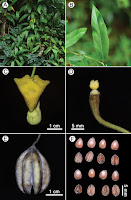 |
| Isotrema pseudohei X.X.Zhu, Jun Wang bis & G.D.Li, in Wang, Li, ... et Zhu, 2021. |
Abstract
Isotrema pseudohei, a new species from Yunnan, Southwest China, is described and illustrated. It is morphologically similar to I. hei and I. moupinense, but differs from the former in the colour of flower and throat, the size of throat and the shape of gynostemium lobes, and from the latter in the shape of lamina and gynostemium lobes.
Keywords: Aristolochia, clarification, morphology, taxonomy
 |
| Isotrema pseudohei X.X.Zhu, Jun Wang bis & G.D.Li from the type locality A habit B leaves C flower (frontal view) D anthers and gynostemium E fruit F seeds. Photographed by Xin-Xin Zhu. |
Isotrema pseudohei X.X.Zhu, Jun Wang bis & G.D.Li, sp. nov.
Diagnosis: Similar to Isostrema hei Lei Cai & X.X.Zhu and I. moupinense (Franch.) X.X.Zhu, S. Liao & J.S.Ma, but significantly differs in the following characters: laminas lanceolate to narrowly lanceolate, basal tube of calyx ca. 1.5 cm long, inside dark purple at base and yellowish white above base; upper tube of calyx ca. 2.3 cm long, inside yellowish white, getting yellow in upper portion; inner surface of limb yellow with purplish red patches; throat yellow, suborbicular, 7–9 mm in diameter; apex of gynostemium lobes acute.
Description: Climbing shrubs. Stems terete, brown pubescent when young, old branchlets glabrous. Petioles 1–2 cm long, appressed villous; laminas lanceolate to narrowly lanceolate, 6.5–17.5 × 2.6–4.5 cm, base round to shallowly cordate, margin entire, apex acute, adaxially sparsely pubescent, abaxially densely villous, especially on veins, lateral veins 4–6-paired. Flower solitary, axillary or on stems; pedicels ca. 3 cm long, densely rusty villous; bractlet 1, lanceolate to elliptic, 3–4 mm long, adaxially subglabrous, abaxially densely rusty villous, inserted on middle part of pedicel. Calyx tube geniculately curved, abaxially yellowish white, densely villous; basal tube ca. 1.5 cm long, inside dark purple at base and yellowish white above base; upper tube ca. 2.3 cm long, inside yellowish white, getting yellow in upper portion; limb discoid, ca. 2.1 cm wide, shallowly 3-lobed, lobes broadly triangular, inner surface yellow with purplish red patches; throat suborbicular, yellow, 7–9 mm in diameter. Anthers 6, oblong, ca. 1.6 mm long, adnate in 3 pairs to base of gynostemium, opposite to lobes. Gynostemium 4–5 mm long, 3-lobed, apex of lobes acute. Ovary terete, ca. 8 mm long, densely brown villous. Capsule cylindric, six arrises, ca. 3 × 2.2 cm. Seeds ovate to elliptic, 3.5–5 × 3–4.5 mm, adaxially deeply concave, abaxially convex, glabrous on both sides.
Etymology: The specific epithet refers to the similarity between the new species and Isotrema hei in the morphology of lamina and flower. The Chinese name is given as “拟何氏关木通”.
Jun Wang, Guo-Dong Li, Juan-Juan Yang, Bin Shen, Chun-Xia Pu and Xin-Xin Zhu. 2021. Taxonomic Studies on the Genus Isotrema (Aristolochiaceae) from China III: I. pseudohei, A New Species from Yunnan, Southwest China. PhytoKeys 186: 43-52. DOI: 10.3897/phytokeys.186.63543

